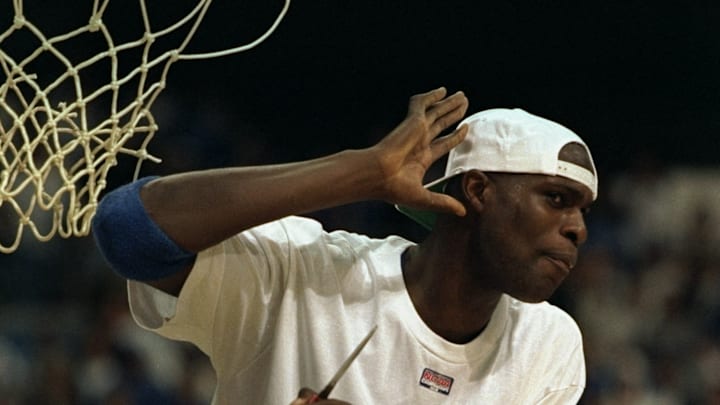he Kentucky Wildcats’ storied basketball program is a tapestry of greatness, woven with players who’ve left indelible marks on the hardwood. While the numbers 13 and 14 might not hang in the rafters, they’ve been worn by some serious ballers who helped shape the legacy in Lexington.
Using only what was accomplished while at Kentucky, we rank the top five to wear number 13 and number 14.
Number 13: The elite of the unlucky digit
Whether seen as unlucky or just underappreciated, the No. 13 jersey has produced gritty guards and dominant bigs alike. Here are the five who made it unforgettable.
No. 5: Phil Argento (1966–69)
A steady hand in Adolph Rupp’s backcourt, Argento played 63 games and totaled 576 points on a sharp 49.25% shooting from the field. He added 145 assists and shot a smooth 81.4% from the stripe, averaging 9.1 points per game over three seasons. A reliable scorer and creator, he was often the glue in a talented rotation—even if overshadowed by flashier teammates.
No. 4: Bobby Perry (2003–07)
Perry brought toughness and range to Tubby Smith’s squads. Over 120 games, he racked up 665 points and 350 rebounds, hitting 33.9% from deep and 76.2% from the line. His senior season featured 8.4 points and 3.5 boards per game, highlighted by timely shooting and leadership. Versatile and clutch, he nudges ahead of Argento thanks to a more modern, all-around role.
No. 3: Ned Jennings (1958–61)
Jennings was a bruiser down low in the late '50s. In just 61 games, he pulled down 448 rebounds—averaging a stout 7.3 boards alongside 9 points per outing. His 1960–61 season was his finest (323 points, 248 rebounds), where he anchored Kentucky’s paint presence. His shooting (38.1%) wasn’t ideal, but his tenacity and production earn him a firm spot in the top three.
No. 2: Isaiah Briscoe (2015–17)
A Calipari-era bulldog, Briscoe played 70 games and delivered 763 points, 376 rebounds, and 259 assists. His sophomore campaign featured 12.1 points, 5.4 rebounds, and 4.2 assists per game—underscoring his do-it-all nature. Briscoe's ability to attack the rim and defend multiple spots was elite, though his 22.9% clip from three capped his ceiling. Still, few could match his all-around intensity.
No. 1: Nazr Mohammed (1995–98)
No one wore 13 better than Nazr. Over 94 games, he scored 814 points and pulled down 532 rebounds while swatting 135 shots at a rate of 1.4 per game. In 1997–98, he averaged 12 points and 7.2 boards while helping lead Kentucky to a national title. His 55.3% field goal percentage and All-SEC honors (First Team AP & Coaches) cement his place at the top of this list. A true Wildcat warrior.
All players who wore No. 13:
Berkley Davis, Robert Davis, Homer Thompson, Louis Robertson, Bill Hamm, Rudy Yessin, J. Ed Parker, Roger Day, Paul Lansaw, Ned Jennings, Phil Argento, Todd Bearup, Nazr Mohammed, Bobby Perry, Michael Porter, Sam Malone, Isaiah Briscoe, Jemarl Baker, Riley Welch, Grant Darbyshire.
Number 14: The teen titans
No. 14 has belonged to scorers, snipers, and national champs. Here are the five who stood tallest in Kentucky blue.
No. 5: Joe Holland (1945–48)
A staple of Rupp’s post-war powerhouse, Holland played in 105 games and dropped in 504 points while helping UK to the 1948 NCAA championship. His best year came in 1946–47, where he earned All-SEC honors after scoring 224 points. While his shooting numbers (39.3% FG, 54.3% FT) reflect the era, his toughness and legacy keep him on this list.
No. 4: Michael Kidd-Gilchrist (2011–12)
A one-and-done with a championship ring, MKG packed a career’s worth of impact into one electric season. He averaged 11.9 points and 7.4 rebounds while shooting 49.1% from the field and playing elite defense. Honors? Try All-SEC, All-Final Four, and Consensus Second-Team All-American. He totaled 476 points and 297 rebounds in just 40 games. If he’d stayed longer, he might top this list.
No. 3: Jeff Brassow (1989–94)
Brassow brought sharpshooting and consistency across 121 games, putting up 807 points while hitting 35.8% from three. He added 334 rebounds and played a key role during the early Pitino years. His standout 1993–94 season earned him All-SEC Tournament honors. A long-tenured, efficient scorer who outlasted MKG in longevity and points.
No. 2: Ronnie Lyons (1971–74)
A scoring threat from the jump, Lyons averaged 10.1 points per game and hit 84% of his free throws over 78 appearances. In 1971–72, he poured in 344 points at 13.2 per game and added 171 assists across his career. Though he didn’t rack up big rebounding totals, his offensive polish and shooting touch make him one of the best 14s in Kentucky history.
No. 1: Erik Daniels (2000–04)
Daniels is the undisputed No. 1 here—and it’s not particularly close. In 127 games, he totaled 1,053 points, 522 rebounds, and 223 assists while shooting 55.3% from the field. His 2003–04 campaign (14.5 points, 6.1 rebounds) earned him First-Team All-SEC honors from the coaches and Second-Team from the AP. A skilled, savvy forward who quietly dominated across four seasons, Daniels set the gold standard for this jersey number.
All players who wore No. 14:
Joseph Hagan, Donald Orme, Bill Barlow, Walter Johnson, Joe Holland, Garland Townes, Phil Johnson, Scotty Baesler, Bill Busey, Ronnie Lyons, Paul Andrews, Jeff Brassow, Heshimu Evans, Erik Daniels, Mark Halsell, Michael Kidd‑Gilchrist, Tai Wynyard, Tyler Herro, Brennan Canada.
Final whistle
From Nazr Mohammed’s paint patrol to Erik Daniels’ versatile dominance, these Wildcats wore 13 and 14 with pride—and power. Whether you remember Briscoe’s bulldog grit or MKG’s one-year magic, these players all carved their place into Kentucky basketball lore.
Who’s your pick for the best to ever wear these numbers? Sound off and keep the legacy alive—because every number tells a story in Lexington.
